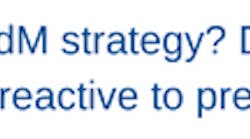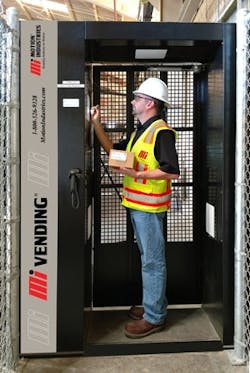Reports are like vegetables: It seems like they’re everywhere and you know they’re good for you in the long run, but they can be a pain to prepare and consume and aren’t always easily digestible. However, just as eating vegetables is an effective practice to improve your physical health, decoding analytics in your vending program is a valuable action to improve the health of your manufacturing operation. Reports highlight your pinch points so you can focus your attention and resources in the right areas to achieve quick improvements.
When it comes to cutting costs, improving efficiencies, and gaining control of inventory, an industrial vending program is a boon to many operations. Vending machines reliably store products and tools and make them accessible according to employees’ need. That alone may relieve a burden on operations. However, the magic doesn’t rest at the bottom of the coil hopper. The true value is in the brains: the software system. When you explore the depths of the machines’ software capabilities, you take your program to the next level. Knowing how to interpret data captured by your vending solutions is guaranteed to change the way you run certain aspects of your business.
What specifics can be mined from vending machines with reporting capabilities? Pretty much whatever you would like to know. Reports can be generated by item, employee, point of use, department, work order, transaction, usage, and, if managed properly in the system, usage costs. Deciding which metrics to track and how frequently to review them requires some thought, but once you know what you are looking for, the information is at your fingertips.
Manage and monitor
Reports are helpful to confirm that procedures are being followed and to shape future changes in protocol. For example, environmental health & safety (EH&S) department managers may use these records to ensure employee compliance with required PPE. Many vending machines have features in their software that will lock out unauthorized employees from retrieving gloves or other items that they don’t need or shouldn’t have. A lot of gloves look alike, and at a glance it can be difficult to tell which are cut-resistant. An employee required to wear cut-resistant gloves can be limited by the machine to remove only that type, and an employee who doesn’t need the more-expensive gloves can be restricted from selecting them. Viewing a summary weekly or monthly report can help a manager see which items are used; this could prompt the decision to regulate different products as needed.
Trend analysis is a mighty sword in slaying inefficiencies. Item use can peak at different times throughout the year in different industries. From a manager’s perspective, setting limits on the quantities that employees can access just makes good sense. Often, employees simply don’t realize the impact of their personal consumption when that’s multiplied across the workforce. A visual survey will note scenarios such as employees forgetting to remove their safety glasses when leaving for lunch and then forgetting to bring them back in, grabbing an extra tape measure when they misplace the one they were using, and taking two pairs of gloves by mistake and neglecting to return the extras if they’re in a hurry. A review can quickly isolate which items tend to be casualties and identify whether certain individuals need reminders of correct procedures.
Improve workflow
Transaction reports can help purchasing managers quickly adjust to changes in their workflow when they see that use of certain items is higher or lower than expected. When a vending program is put in place, the data that is available at the time of equipment installation is used to determine which items will be vended and in what quantities.
Managers should understand that course corrections will be necessary as new data is recorded over time. In some cases, implementing vending is the first step for the management team to collect and manage the information they know they don’t have but need. As time passes, manufacturing processes change: New lines are added or eliminated, and employee headcount ebbs and flows. Items that were considered good candidates for vending in fact don’t turn quickly enough and are replaced with higher-turning items, or items turn at a much faster rate than anticipated. Reports clearly capture these details so that decisions can be made quickly, which prevents a backlog or potential downtime.
Reports can help supervisors stay on top of day-to-day equipment monitoring. In some situations, employees are expected to communicate the status of their equipment when it is returned at the end of their shift, or notify their supervisors of any red flags. Some vending machines can be programmed to give workers the option of updating the status of equipment being returned—noting if maintenance is required, for example. Also, when an employee badges in to remove and return a piece of equipment, vending software creates a record of accountability by showing who is responsible for the asset during that time. Supervisors can address problems immediately by reviewing the data regularly and also ascertain how workers are using the consumable or durable goods during their shifts.
Manage equipment costs
Analyzing reports helps management evaluate equipment operations. Every facility depends on healthy equipment operating at peak performance. Balancing the investment of parts and labor against the lifespan of an asset can seem more of an art than science without adequate statistics. Work-order reporting has proved helpful in making decisions about whether to replace or maintain existing assets. When an employee creates a work order each time that an asset is serviced, those parts and labor become part of the asset’s history and feed the bill of materials. Regularly reviewing the work-order summary ensures that the relevant data pertaining to work performed on a machine is entered and costs are tracked and that information is transmitted to the customers’ PM software. Over time, the work order report captures information that can remove the guesswork from what can be difficult business decisions.
Consolidate knowledge
Reports consolidate information so that critical and relevant details don’t become log-jammed at one point of contact. A manager’s eyes can’t be everywhere on the plant floor at all times across all shifts. Facilities often rely on busy employees to notify the supervisor on their shift and for those supervisors to inform their colleagues – a scenario ripe for a breakdown in communication. For example, if an employee going off shift notices an abnormality in the drill he’s been using, where does that knowledge go and what actions are taken?
Megan Mullins is part of Motion Industries’ On-Site Solutions team in Birmingham, AL.
When data is coming to a management team from multiple sources at irregular intervals, there are too many guardians at the gate. Each supervisor and manager is responsible for his or her own special corner of the operation but may not have a bird’s-eye view of the other aspects. Reports are able to synthesize multiple streams of data into a cohesive picture of the health of the business and can be easily shared and analyzed to zero in on pinch points.
No matter how tightly the ship is run, seeing the hard data can be eye-opening for a manager. Instead of wondering whether inventory levels are remaining stable, assets are being managed correctly, billing is allocated to the correct departments, and the company’s budget is as accurate as it could be, mining the reports can place all of this intelligence at one’s fingertips.
Don’t you feel better already? Like vegetables, reports are good for you and your operations, can be prepared in a variety of ways, and help you enjoy more vitality in your workday.


